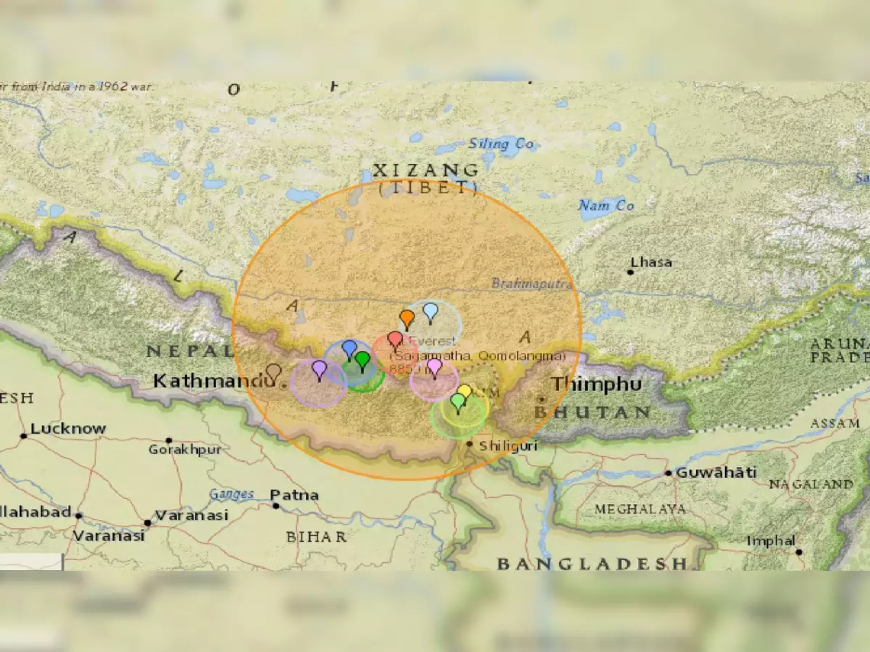Why the Earthquake in Tibet Was Felt in Delhi and Bihar
Discover why the tremors from a Tibet earthquake reached as far as Delhi and Bihar. Learn about seismic activity, plate tectonics, and why distant regions feel the impact.

Why Were Earthquake Tremors from Tibet Felt as Far as Delhi and Bihar?
Earthquakes often shake the ground far beyond their origin, as seen in the recent tremors from Tibet that reached Delhi and Bihar. To understand how and why this happens, we need to explore the mechanics of earthquakes and how seismic energy spreads. Let’s break it down point by point for better clarity.
1. What Causes Earthquakes?
- Earthquakes occur when stress in the Earth's crust is suddenly released due to the movement of tectonic plates.
- These plates float on the semi-fluid layer beneath the Earth’s surface, and their collisions or separations create immense energy.
- This energy radiates outward in the form of seismic waves, causing the ground to shake.
2. Tibet: A Highly Active Seismic Zone
- Tibet is located near the collision boundary of the Indian Plate and the Eurasian Plate.
- The collision between these massive plates creates immense pressure, making Tibet one of the most earthquake-prone regions in the world.
- The same tectonic activity that gave rise to the Himalayas also triggers frequent seismic events in this region.
3. How Seismic Waves Travel Long Distances
- When an earthquake occurs, it sends out seismic waves in all directions.
- These waves can travel thousands of kilometers depending on the energy released during the earthquake and the type of soil and rock they pass through.
- There are two main types of seismic waves:
- Body Waves: These travel through the Earth’s interior and are faster.
- Surface Waves: These travel along the Earth’s crust and are slower but more destructive.
4. Why Delhi and Bihar Felt the Tremors
- Delhi and Bihar lie on the Indo-Gangetic Plain, an area made up of alluvial soil, which is excellent at conducting seismic waves.
- The soft and loose soil amplifies the energy of the seismic waves, making even distant earthquakes noticeable.
- The flat geography of the region allows seismic energy to travel without much resistance.
5. Magnitude and Depth of the Tibet Earthquake
- The strength (magnitude) of an earthquake and its depth significantly impact how far its tremors are felt.
- Shallow earthquakes (with a depth less than 70 km) tend to cause stronger surface waves, which travel farther.
- If the Tibet earthquake had a high magnitude and a shallow depth, it could easily send tremors to distant places like Delhi and Bihar.
6. Proximity to Fault Lines
- Fault lines are cracks in the Earth’s crust where tectonic plates meet or slide past each other.
- Delhi and Bihar are relatively close to major fault lines like the Himalayan Frontal Thrust, making them sensitive to tremors originating in nearby regions like Tibet.
7. Why Some People Felt It More Than Others
- People living on higher floors of buildings are more likely to feel earthquake tremors due to the swaying of structures.
- Those on soft or reclaimed land, which amplifies vibrations, will also experience stronger shaking compared to those on rocky or stable ground.
8. Lessons from the Tremors
- These events remind us of the importance of earthquake preparedness, especially in regions prone to seismic activity.
- Regular building inspections, adherence to earthquake-resistant construction norms, and public awareness campaigns are crucial for minimizing damage and saving lives.
9. The Role of Technology in Monitoring Earthquakes
- Modern technology, such as seismographs and satellites, helps detect and analyze earthquakes in real-time.
- Early warning systems can alert people to evacuate or take cover before tremors reach their location.
Conclusion
The tremors felt in Delhi and Bihar from a Tibet earthquake highlight the interconnectedness of our planet's tectonic movements. Factors like the magnitude of the quake, the type of soil, and proximity to fault lines play a significant role in determining how far the shaking is experienced. Understanding these dynamics not only satisfies curiosity but also underscores the need for preparedness in earthquake-prone areas.
This detailed explanation simplifies the complex science behind seismic activity, ensuring a clean, engaging, and reader-friendly experience.
What's Your Reaction?






















































